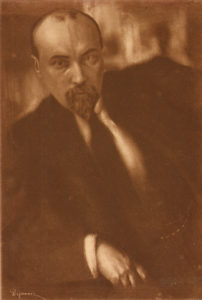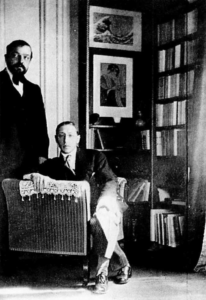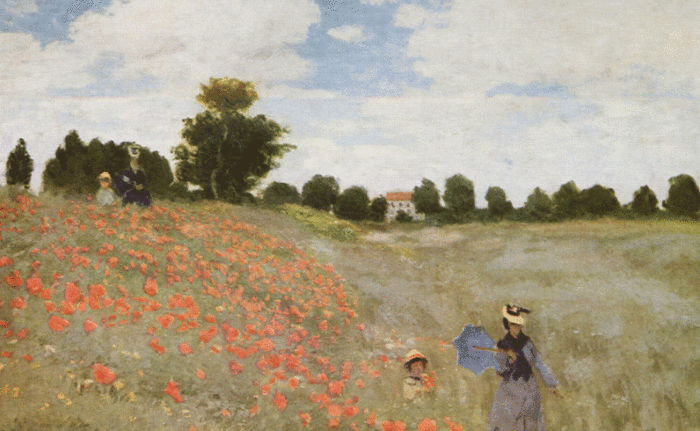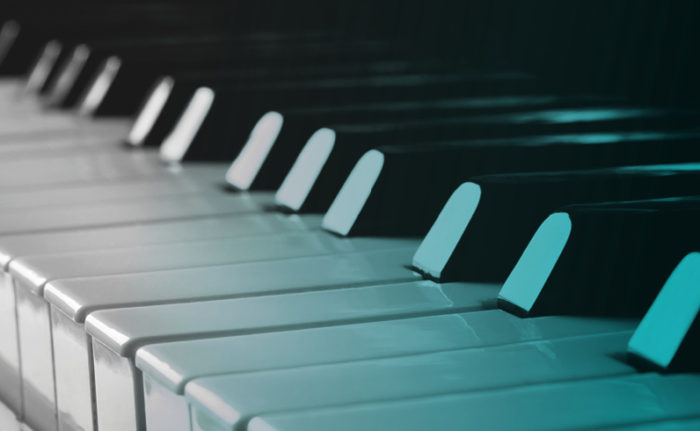Above: One of Nicholas Roerich’s original set designs for The Rite of Spring.
After the failed revolution of 1905, a cloud of apocalyptic doom seemed to hover over the Russian Empire. With freedom of speech severely curtailed, many artists turned to increasingly subjective, mysterious sources of inspiration. Some, like the composer Alexander Scriabin, were captivated by the spiritualist mysticism of theosophy; others looked far back into the prehistoric past, feeling that modern civilization had somehow failed and lost touch with nature.
The poet Alexander Blok, for instance, wrote longingly of primeval man and nature: “He lived with her in intimate union, feeling the soul of this being, with her constant mysterious treacheries and her vivid colors, as closest of all to his own.” For Blok and others, the artist’s mission was to revivify a stultifying culture by reconnecting it with the primal past.
Genesis of a Revolution
Amid this heady Zeitgeist, Stravinsky was struck with inspiration: “One day, when I was finishing the last pages of L’Oiseau de feu [The Firebird] in St. Petersburg, I had a fleeting vision […] I saw in imagination a solemn pagan rite: sage elders, seated in a circle, watched a young girl dance herself to death. They were sacrificing her to propitiate the god of spring.”

With newfound fame after the triumphant success of The Firebird during the 1910 season of the Ballets russes in Paris, Stravinsky sought out the artist and archeologist Nicholas Roerich, the foremost authority on prehistoric Russia of the time. Together they devised a scenario for a ballet unlike any other; in place of a plot, the ballet would be based on the rituals of ancient Slavs (minus the dancing to death—a trope of Romantic ballet that can be traced back to Giselle). Though modern scholars have since questioned some of Roerich’s conclusions about prehistoric Slavs, the archaeological intent of the ballet was sincere, and nearly everything in the ballet was supported by contemporary research.
After setting the project aside temporarily to compose Petrushka and a few other works, Stravinsky composed the first half of the ballet in 1911 and the second half in 1912 (the gap was the result of the premiere being pushed back from the 1912 season to the 1913 season).
There are few instances in history when a single artwork transcends its influences and truly breaks new ground. Stravinsky’s score for The Rite of Spring is one of those instances. Carried away by visions of the primordial past, Stravinsky wrote half an hour of music that broke nearly every established rule of good composing, and yet the score is gripping from its first note to its last. Many scholars have since attempted to devise theories to explain this music, and while they have discovered many interesting patterns, the score’s elemental power remains mysterious. Often composing with astonishing speed, Stravinsky later recalled that “I was guided by no system…I had only my ear to help me.”
A New Sound for a New Era
The score unleashed shocking dissonances and strange, new sounds from an enormous orchestra. But perhaps even more astonishing is its rhythmic complexity; on many pages the meter (fundamental beat pattern) is in a constant state of flux. The music’s construction, too, was original; in place of seamless transitions and organic development, Stravinsky’s score often juxtaposed blocks of music to create extreme contrasts. For all of its assaults on convention, however, the score is based on a number of quite singable melodies, some of which have been shown to be derived from authentic folksongs associated with ancient Slavic festivals. Though many are most struck by its violent passages, the score also contains many delicate moments of great beauty.

Likewise, through many remember the terror of the ballet’s human sacrifice, the music also expresses a primal joy and connection with nature. Indeed, the joy and terror seem to meld into a single electrifying emotion; after playing through the first half of the ballet with Stravinsky at the piano, the French composer Claude Debussy wrote that “It haunts me like a good nightmare, and I try in vain to recover the impression.”
With the score finished, sets and costumes were designed by Roerich and choreography was provided by Vaslav Nijinsky, the Ballet russes’ star male dancer (and sometime lover of the ballet’s impresario, Sergei Diaghilev). Nijinsky seems to have tried to match Stravinsky’s revolutionary music with choreography that deliberately went against the traditions of classical ballet. Though the exact choreography has been lost, it was reconstructed by the Joffrey Ballet in 1987 based on surviving documents, reviews and the memories of dancers who were in the original production. The sets and costumes are also very close to the originals. You can watch it here:
The infamous premiere took place on May 29, 1913 at the Théâtre des Champs-Élysées in Paris. After only a few minutes, a riot broke out as the work’s critics began to boo and hiss while its champions responded in kind. Stravinsky was distraught; it seems he had sincerely expected The Rite would be another popular success along the lines of The Firebird and Petrushka. The riot may have been partly manufactured by Diaghilev, who liberally distributed free tickets to young, bohemian, artistic types and strategically sat them near the high society ladies and gentlemen who had come to see Les Sylphides, a traditional ballet to music of Chopin that shared the program. After it was all over Diaghilev is reported to have said, “Exactly what I wanted.”
Indeed, a legend was born; ironically, this ballet inspired by ancient history quickly became a symbol of modernity at its most sophisticated. Klaus Obermaier’s choreography, for instance, uses Ars Electronica Futurelab’s 3D animation to reinterpret the music as an exploration of humankind’s relationship to technology:
Despite the scandalous premiere and continued controversy, subsequent performances of the ballet were generally well received, and the music alone quickly became a concert hall staple, a test of any orchestra’s skill. The Rite would become one of the most imitated scores of the twentieth century; there is scarcely a movie action sequence that doesn’t invoke its wild musical language. Few composers, however, have matched the power of the original, which continues to fascinate and provoke to this day. —Calvin Dotsey
Don’t miss Stravinsky’s The Rite of Spring May 18, 19 & 20, 2018! Get tickets and more information at houstonsymphony.org.



